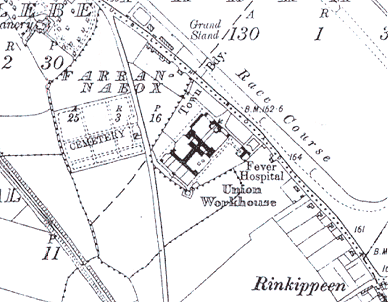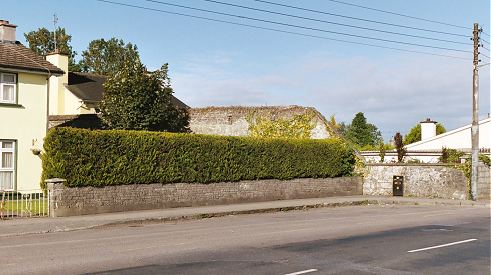Tuam, Co. Galway
Tuam Poor Law Union was formally declared on the 19th September 1839 and covered an area of 214 square miles. Its operation was overseen by an elected Board of Guardians, 31 in number, representing its 13 electoral divisions as listed below (figures in brackets indicate numbers of Guardians if more than one):
Co. Galway: Abbey (2), Annaghdown, Cummer, Clare Tuam, Cloonbern (3), Downpatrick (3), Dunmore (3), Headford (3), Kilbanon (2), Killererin (2), Lisgeevy (3), Monivea, Tuam (6).
The Board also included 10 ex-officio Guardians, making a total of 41. The Guardians met each week on Saturday.
The population falling within the Union at the 1831 census had been 74,155 with divisions ranging in size from Monivea (population 2,418) to Tuam itself (14,381).
The new Tuam Union workhouse was erected in 1840-1 on a six-acre site on the Dublin Road half a mile to the south-east of Tuam. Designed by the Poor Law Commissioners' architect George Wilkinson, the building was based on one of his standard plans to accommodate 800 inmates. Its construction cost £6,700 plus £1,400 for fittings etc. The workhouse was declared fit for the reception of paupers on 15th August 1842. However, because of difficulties in collecting the poor rate needed to operate the workhouse, it did not receive its first admissions until 4th May 1846, and only then after the Poor Law Commissioners had issued the Guardians with a writ of mandamus.
The workhouse site location and layout are shown on the 1918 OS map below.

Tuam workhouse site, 1918.
The buildings followed Wilkinson's typical layout. An entrance and administrative block at the north-east contained a porter's room and waiting room at the centre with the Guardians' board room on the first floor above.
The main accommodation block had the Master's quarters at the centre, with male and female wings to each side. At the rear, a range of single-storey utility rooms such as bakehouse and washhouse connected through to the infirmary and idiots' wards via a central spine containing the chapel and dining-hall.
During the famine in the mid-1840s, sheds were erected to accommodate 100 additional inmates and 50 fever patients. A fever hospital was subsequently erected at the east of the site.
After the creation of the Irish Free State in 1921, the workhouse continued to be occupied by a small number of troops. From 1925 to 1961, the site operated as a mother and baby home, run by the Bon Secours Sisters. In recent years, the establishment has become the focus of a scandal after the discovery of the remains of almost 800 babies in a septic tank at the site, apparently placed there by the nuns.
The site is now occupied by housing and the only remnant of its former use is an old wall at its northern edge.

Tuam former workhouse site from the east, 2003.
© Peter Higginbotham.
Records
Note: many repositories impose a closure period of up to 100 years for records identifying individuals. Before travelling a long distance, always check that the records you want to consult will be available.
- Galway local archives, Island House, Cathedral Square, Galway. Holdings include Board of Guardians' minutes (1839-1921).
Bibliography
Links
- None.
Unless otherwise indicated, this page () is copyright Peter Higginbotham. Contents may not be reproduced without permission.


